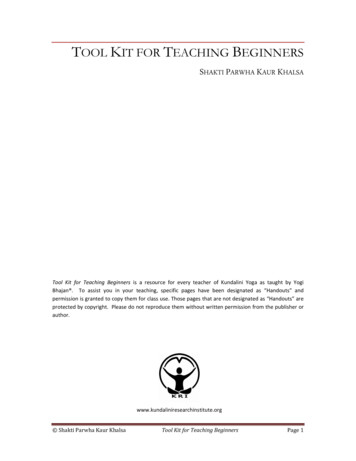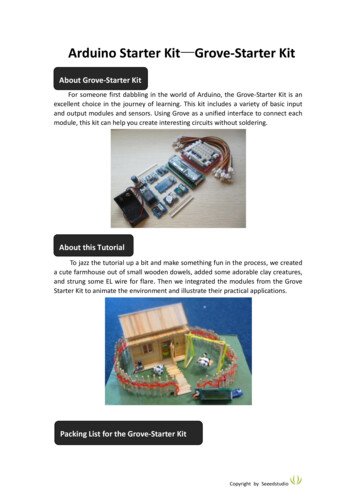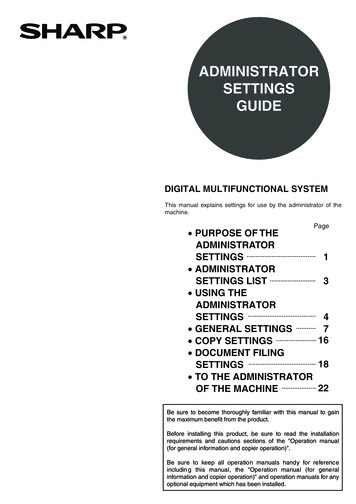
Transcription
TOOL KIT FOR TEACHING BEGINNERSSHAKTI PARWHA KAUR KHALSATool Kit for Teaching Beginners is a resource for every teacher of Kundalini Yoga as taught by YogiBhajan . To assist you in your teaching, specific pages have been designated as “Handouts” andpermission is granted to copy them for class use. Those pages that are not designated as “Handouts” areprotected by copyright. Please do not reproduce them without written permission from the publisher orauthor.www.kundaliniresearchinstitute.org Shakti Parwha Kaur KhalsaTool Kit for Teaching BeginnersPage 1
INTRODUCTIONWe were all beginners in 1969, when Yogi Bhajan started teaching Kundalini Yoga, the Yoga of Awareness,in the United States. He was the first Master ever to freely and openly teach this sacred science. KundaliniYoga opened up a whole new world, even for those who had practiced other forms of yoga.“I have not come to gain disciples, I’ve come to train teachers.” –Yogi BhajanHe made everything so simple, explained things so clearly, and made each class so much fun, thatstudents flocked to his classes. He taught twice a day, six days a week and one class on Sunday.I was privileged to attend his classes every evening and two mornings every week. Within two months Iwas teaching. I relied heavily on the notes I had taken during his classes (most of my notes wereincorporated later into “Sadhana Guidelines”), and I relied even more heavily on the connection with theInfinite Wisdom created by chanting the Adi Mantra, Ong Namo Guru Dev Namo.The basic, fundamental information that Yogi Bhajan gave us about the 3HO way of life, the “yogictidbits,” the meditations, mantras, and exercise sets and kriyas he taught in that first year are what I havecontinued to teach in my Beginners’ Series. Much of this material can be found in Kundalini Yoga: TheFlow of Eternal Power, the book he directed me to write.Over the years I’ve found that what works best for me – and the students – is to introduce people toKundalini Yoga through a series of six classes. In this manual, I have outlined and “packaged” the contentsof each class in the series so that you can use it as the basis for your own “Beginners’ Series.”With Kundalini Yoga Sadhana Guidelines, 2nd Edition, and my book, Kundalini Yoga: The Flow of EternalPower, and your Aquarian Teacher Manuals, you have everything you need to teach beginners. Justremember to “Keep it Simple!”As you gain experience in teaching, you may choose different sets of exercises or use different mantras. (Ialso try to introduce them to the Aquarian Sadhana mantras.) My purpose in preparing this Tool Kit is toprovide a “teacher‐friendly,” organized presentation of a basic Beginners’ Series to get you started.—Shakti Parwha Kaur KhalsaTHE FIRST PRINCIPLE OF A TEACHER IS “I AM NOT.” IF YOU CANNOT PRACTICESHUNIYA, YOU CANNOT BE A TEACHER OF KUNDALINI YOGA.–THE TEACHINGS OF YOGI BHAJAN Shakti Parwha Kaur KhalsaTool Kit for Teaching BeginnersPage 2
BASIC COMPONENTS OF EVERY CLASSA TEACHER’S ATTITUDE AND INTENTION: A Teacher teaches with his/her psyche. Remind yourself totake the “Teacher’s Oath” before every class.I am not a woman,I am not a man,I am not a person,I am not myself,I am a Teacher. TUNING IN IS ESSENTIALPRANAYAMKUNDALINI YOGA KRIYAMANTRAMEDITATIONRELAXATIONCLOSE WITH “LONG TIME SUN SHINE” SONGPRAYER TO ENDPOINTS TO REMEMBERIn every class mention our Teacher, Yogi Bhajan, with appreciation and gratitude. Allow your students tobenefit from the Golden Chain and a connection with his consciousness, as well as the wealth of books,lectures and DVDs that are available.Music is a wonderful addition to any class; but for beginners’, it’s best to chant a capella for a while sothat they come to a clearer understanding and experience of naad, mantra and jap. Once you beginincorporating music into the class, use only 3HO music. No matter how lovely other music may be, it is notacceptable for Kundalini Yoga classes. Remember to use music with discretion and when appropriate anduseful.When teaching beginners, make it easy and “do‐able” for them. Encourage them to feel comfortable andsuccessful, even if they can’t do everything perfectly.Demystify Kundalini Yoga. It’s really quite simple, so keep it simple.Remember you are introducing them to a new physical, mental, and spiritual world. Kundalini Yoga is theYoga of Awareness, it is not just a bunch of exercises.Whenever there are new students in the class, be sure to ask if they have done any yoga previously, andpoint out how Kundalini Yoga is different. Also, advise them that because it is a beginners’ class, you will Shakti Parwha Kaur KhalsaTool Kit for Teaching BeginnersPage 3
explain everything as if everyone is a beginner (and do it). Even many long time students of regular classesmay not have been taught some of the fundamentals that Yogi Bhajan taught us in the beginning.Give every class a theme. Introduce the theme at the beginning, and explain its concepts in‐between andduring exercises as appropriate. You may not be able to fit in all of the items listed under each topic, soprioritize according to the needs of the students and the time frame of the class. (I usually take 1 1/2hours for a Beginners class, to allow for lots of explanation, and a long relaxation at the end. Even so,there isn’t always time for a special meditation as well as teaching a mantra. It’s ideal to introduce a newmantra each class.)Have students relax after each exercise, unless otherwise noted. This allows the glandular secretions thathave been stimulated to circulate throughout the bloodstream, bringing balance.TEACHER OR INSTRUCTORAn Instructor usually does the exercises with the students, a Teacher does not. Kundalini Yoga teachersare Teachers! A Teacher may demonstrate an exercise to get the students started, but the Teacher’s job isto watch and guide the students, helping them by verbal correction and encouragement.In Kundalini Yoga, as taught by Yogi Bhajan, we Teach, and we do not physically touch the students toadjust them. All that is necessary can be done by explanation.GET OFF THE BENCHWalk around among the students when suitable, to check their posture, mudra, breathing. (Butremember, we teach “hands–off”)SPEAK CLEARLYProject: Are you speaking loud enough so that the students in the back of the room can hear you? (Askthem!) Speak clearly and distinctly. What you have to say is valuable.QUESTIONSBefore the closing with the Long Time Sun Shine song, ask for any questions and be available after classfor a few minutes to talk with students.TEACH WHAT YOU KNOW, AND TEACH PEOPLE TO RELAX.—THE TEACHINGS OF YOGI BHAJAN Shakti Parwha Kaur KhalsaTool Kit for Teaching BeginnersPage 4
QUESTIONNAIRE AND FOLLOW‐UPIt’s very useful to have new students fill in a questionnaire. A sample is enclosed which you can revise tosuit your needs. Most students will appreciate it (some may not!) if you call or e‐mail them after a fewdays, or a week or two, to find out if they have any special questions. The idea is to let them know youcare about their progress and want to be of help. Note: If you form an e‐mail group, to communicate withthem all via e‐mail newsletter, be sure to send it via “blind copy” so that you don’t give out any student’saddress to the others.BE ON TIMEA good yoga class always starts on time and ends on time.COVER YOUR HEAD WHEN TEACHINGWear a white cotton or other natural fiber head covering when you teach. It sets an example for yourstudents and protects you and your energy as you teach.SADHANA“Take to heart one thing, sadhana, aradhana, prabhupati You want to be a great teacher, you want Godto work for you, then do your sadhana. Do it as it is, and you’ll become Lord Master God yourself. There isno sacred secret here which we have not shared. But if you get up yourself at 11 o’clock and thinkeverybody around you will be impressed, you are wrong ”“ Make your third eye bright and beautiful, so you can come out of the dark and make others to comewith you.”–Yogi BhajanGET UP IN THE AMBROSIAL HOURS, WHEN THE SUN IS AT A SIXTY DEGREEANGLE, EXERCISE AND STIMULATE YOURSELF, THEN SIT AND MEDITATE—JUST CLEAN THE SUBCONSCIOUS. IT’S NOT A BIG RELIGIOUS THING;IT’S A VERY PERSONAL THING.—THE TEACHINGS OF YOGI BHAJAN Shakti Parwha Kaur KhalsaTool Kit for Teaching BeginnersPage 5
TUNING IN WITH THE ADI MANTRA: ONG NAMO GURU DEV NAMOBefore every Kundalini Yoga class or practice session, we have to tune‐in. One way to explain the processof tuning in is to suggest that if you were going to watch this on TV, you’d have to turn to the rightchannel. The code letters, for the ”station” we want to access in our practice of Kundalini Yoga is reachedby the sounds: ONG NAMO GURU DEV NAMO.ONG NAMO GURU DEV NAMO invokes the blessings of the Creator, the Divine Teacher within each one ofus. It links us with the entire line of spiritual teachers who have handed down this ancient wisdom frommaster to disciple through the ages.Many people approach yoga from a purely physical standpoint, and that’s OK, because it has tremendousphysical benefits. But do not underestimate its other aspects! The effects go far deeper than justphysical improvement. Kundalini Yoga is the Yoga of Awareness.Kundalini Yoga is a science, a sacred science; in other words, it is a spiritual practice—and spiritualitycannot be taught, it has to be caught, like the measles. It is contagious. You have to get it fromsomeone who’s got it. Which is why you want to tune‐in to the line of teachers—they’ve already “got it”—and that includes, of course, our Teacher, Yogi Bhajan, who is Master of Kundalini Yoga. It does notmean that you are tuning into his finite personality, however. Instead, you are calling upon the highestaspects, the divine consciousness, of all the Teachers in the Golden Chain. At the same time, you arestimulating and awakening your own wise, elevated, and divine Self, and making a conscious connectionwith the One who created you, who breathes in you. Whew! Not a small thing! This is a major,important mantra.You could even consider chanting as a sort of “connection by osmosis.” ONG NAMO GURU DEV NAMO isthe phone number of the Divine Teacher within you. So, turn the dial of your mind, and switch to thechannel that will give you the clearest reception—the least static and interference from the ego—of thetechnology and the vibration that comes with it. ONG NAMO GURU DEV NAMO assures the correct innerguidance for your practice of Kundalini Yoga as taught by Yogi Bhajan .THIS IS A TEACHER: YOU TAKE THE TEACHINGS AND YOU FLOW. IT’S ONELINK. SCRIPTURALLY, THEY CALL IT THE GOLDEN CHAIN OF TEACHERS.—THE TEACHINGS OF YOGI BHAJAN Shakti Parwha Kaur KhalsaTool Kit for Teaching BeginnersPage 6
BEGINNERS’ SERIESSIX SAMPLE CLASSESThe following six Beginners’ classes present six of the major facets or aspects of Kundalini Yoga as taughtby Yogi Bhajan . They provide a foundation and framework of understanding and motivation. Feel free tothink up more creative or exciting titles!1. BREATH OF LIFE IS YOUR LIFE: PRANA AND PRANAYAM2. CREATURES OF HABIT: APANA, DIGESTION, AND ELIMINATION3. WHERE ARE YOU AT? CHAKRAS AND THE KUNDALINI4. EVERYBODY IS A HEALER5. HOW TO HAVE A REALLY GOOD NIGHT’S SLEEP6. GREAT DAY IN THE MORNING! HOW TO GET UPIf you want to do a longer Series, you can add classes such as: MANAGING ANGERMALE‐FEMALE RELATIONSHIPSJUST FOR WOMEN: THE GRACE OF GOD MEDITATIONMAGIC WORDS: MANTRAS AND HOW THEY WORKTHE TEN BODIESMANAGING STRESSSPIRITUAL PATH AND THE WAY OF DISCIPLINE Shakti Parwha Kaur KhalsaTool Kit for Teaching BeginnersPage 7
CLASS ONE OUTLINEBREATH OF LIFE IS YOUR LIFEPRANA AND PRANAYAM1. Introduce Long Deep Breathing during Tune‐in and teach Breath ofFire in detail.2. Introduce Venus Lock: Walk around and check each student’s mudra.Make sure the thumbs are parallel to each other, not crossed, and notwo fingers of the same hand are next to each other.3. Pranayam Series 1 from Kundalini Yoga Sadhana Guidelines, 2nd Ed.4. Select from the following Kriyas:Kriya for Elevation (Flow of Eternal Power, p. 231 or The AquarianTeacher Yoga Manual, p. 343)Easy Set (from Flow of Eternal Power, p. 235) Write‐up included.5. Three Simple Exercises (This is their homework, too.):a. Ego Buster: arms up at 60 degrees, pads of the fingers curledtightly and the thumbs extended, pointing directly up (NOTtoward each other) to the sky, with Breath of Fireb. Camel Ride: spine flex with hands on shins or anklesc. Stretch Pose with Breath of Fire6. Long Deep Relaxation: Always play music, or sing or chant tostudents after taking them through a relaxation sequence (startingwith the toes, relaxing each part of the body) to keep their mindscalmly occupied.7. Close: Long Time Sun Shine Song and Long Sat Nam, 1‐3 times. Shakti Parwha Kaur KhalsaTool Kit for Teaching BeginnersPage 8
CLASS ONE NOTESBREATH OF LIFE IS YOUR LIFEPRANA AND PRANAYAMCLASS DISCUSSION TOPICS The Source of Prana (when they split the atom they got prana!) The Function of the Two NostrilsIntroduce the three major nadis—ida, pingala, and sushmana Life and Death Depend Upon Breath G‐O‐D: Generator Organizer and DelivererNew students especially need to understand that our reference toGod is not a religious concept, but the power, intelligence, energy,and consciousness that Generates, Organizes and then eitherDelivers or Destroys all of creation. There is One G‐O‐D living andbreathing in each of us.CLASS HANDOUTS Questionnaire Mantra Sheet: Adi Mantra, Sat Nam, Long Time Sun Shine Song Homework: Exercises 5 a, b, c, 1 to 2 minutes each; and Breathof Fire: 5 minutes. Start with 30 second segments, graduallybuild to 1 minute segments, then 2 minutes, and so on. Shakti Parwha Kaur KhalsaTool Kit for Teaching BeginnersPage 9
NEW STUDENT QUESTIONNAIREDATETo help us serve you better, please fill in the following information:Male FemaleName (please print) AgeAddressCity State ZipPhone Number ( ) (h) ( ) (w)E‐mail:Is this your first experience with Kundalini Yoga? Yes NoIf not, where/when did you study?What do you want to achieve by taking these classes? Improve health learn to relax reduce stress gain peace ofmind develop inner increase energyawareness doctor/chiropract otheror recommendedHave you even done any other kind of yoga or meditation?Yes NoIf so, please describe Shakti Parwha Kaur KhalsaTool Kit for Teaching BeginnersPage 10
Please list any specific questions or areas of interest.Please list any injuries that may affect your practice today.How did you hear about this class? Friend/Teacher Received an e‐mailreferral website Received a mailing otherOther Comments Shakti Parwha Kaur KhalsaTool Kit for Teaching BeginnersPage 11
CLASS ONE: BREATH OF LIFE IS YOUR LIFEMANTRA SHEETSAT NAM!Use it as a greeting, anytime, anyplace. It reinforces the divine consciousness ineveryone.Sat Nam is the seed (bij) Mantra. SAT means Truth or Essence; NAM means Name orIdentity; often translated as “Truth is my identity; God’s name is Truth.”Pronunciation: SAT NAM is often transliterated as Sat Naam, which rhymes with “butmom”; the ‘a’ is short as in ‘hut’, and the ‘aa’ is long as in ‘mom’.ONG NAMO GURU DEV NAMOThis mantra calls upon the Creator, the Divine Teacher inside every human being. Itestablishes a strong and clear connection so that we can receive the highest guidance,energy and inspiration. Always chant it at least three times before beginning anypractice of Kundalini Yoga as taught by Yogi Bhajan .ONG is the Creator; NAMO means reverent greetings or salutations; GURU is the giver ofthe technology (GU darkness, RU light ); DEV means transparent (non‐physical).Pronunciation: ONG uses the conch in the nasal cavity to create this initiating sound;NAAMO GUROO DAYV NAAMO is the traditional transliteration.THE LONG TIME SUN BLESSING SONGAll Kundalini Yoga as taught by Yogi Bhajan classes use the Sun Shine Song to closeeach class. It can be sung or recited, as a positive affirmation, bringing blessings to all.May the Long Time Sun Shine Upon YouAll Love Surround YouAnd the Pure Light Within YouGuide Your Way On.Sat Nam. Shakti Parwha Kaur KhalsaTool Kit for Teaching BeginnersPage 12
CLASS TWO OUTLINECREATURES OF HABITAPANA, DIGESTION AND ELIMINATION1. Tune‐In with the Adi Mantra2. Pranayam: Left Nostril Breathing3. Two Simple Exercises:a. Sufi Grind (or Stomach Grind): 26 times in each direction,beginning counterclockwise, is great for digestion.b. Rock Pose: Yogi Bhajan said that you could digest rocks if yousat in this pose every day.4. Select from the following Kriyas:Vatskar Dhouti Kriya from Kundalini Yoga: Flow of Eternal Power,p. 255 or Apana Kriya from Kundalini Yoga Sadhana Guidelines,2nd Ed.Beginner’s Cleansing Set from Kundalini Yoga Sadhana Guidelines,2nd Ed.5. Kirtan Kriya: The Panj Shabd and changing our habits.6. Long Deep Relaxation: Always play music, or sing or chant tostudents after taking them through a relaxation sequence (startingwith the toes, relaxing each part of the body) to keep their mindscalmly occupied.7. Close: Long Time Sun Shine Song and Long Sat Nam, 1‐3 times. Shakti Parwha Kaur KhalsaTool Kit for Teaching BeginnersPage 13
CLASS TWO NOTESCREATURES OF HABITAPANA, DIGESTION AND ELIMINATIONCLASS DISCUSSION TOPICS EATING HABITS: CHEW YOUR FOOD!“Remember: There are no teeth in the stomach.” –Yogi BhajanVegetarian: As humans we have no claws or fangs; we’re not built toeat meat. Long digestive track built for processing fruits, vegetablesand breaking down grains, nuts and seeds. Note: Meat generatesexcessive uric acid in the body’s tissues; fish causes dehydration inthe tissues, which is already a problem in the average American’sdiet. FOODS FOR HEALTH AND HEALINGTrinity Roots: Garlic/Onions/GingerAdd them to most anything! Kitcheri is a healing food thatincludes these three roots along with mung beans and rice.Turmeric: Great for the joints!Golden Milk is a great Yogic recipe that includes turmeric.Yogi Tea (and Ginger Tea)Includes Cinnamon (bones), Black Pepper (blood purifier), Cloves(nervous system) Cardamom (colon), Milk (assimilation), and BlackTea (alloy) Shakti Parwha Kaur KhalsaTool Kit for Teaching BeginnersPage 14
CLASS HANDOUTS Creatures of Habit: An Essay Mantra Sheet: The Panj ShabdSA TA NA MA: The mantra to change habit patterns Recipes: Kitcheri, Golden Milk, Yogi Tea and Ginger TeaIncludes Recommended Cookbooks: Foods for Health and Healing byYogi Bhajan; From Vegetables with Love; Golden Temple VegetarianCookbook; A Taste of India;Hypoglycemia—A New Approach;Sugar Blues Shakti Parwha Kaur KhalsaTool Kit for Teaching BeginnersPage 15
CLASS TWO: CREATURES OF HABITAN ESSAYHABITS RULE OUR LIVESThe concept we’re discussing today is the “liberated man,” also known as Self‐Mastery.Do you ever feel like you’re a slave to your habits? Thoughts? Or emotions? It takes 40days to establish a habit, 90 days to confirm it, and 120 days for it to be acknowledged.You don’t break a “bad” or demoting habit, you replace it with a positive, promotinghabit.Habit patterns are like river beds, made by water flowing along the same course.These patterns exist in our subconscious minds from past actions, especially from pastlives. So we automatically fall into these same patterns of behavior and call it, “goingwith the flow.” These patterns are called samskaras.1 Karma is the way we act out oursamskaras.The most effective tool for rerouting or eliminating the negative, self‐defeatingsamskaras in the subconscious is mantra. Chanting literally redefines and reroutes thecourse of the flow of habits that compel and impel our actions.With new promoting patterns replacing old negative patterns, you don’t have tofall into the old rut again and again, and thus your life changes for the better.1To learn more about samskaras, karma, and the mind, read The Mind by Yogi Bhajan and Gurucharan Singh Khalsaor How to Know God by Christopher Isherwood and Swami Prabhavananda. Shakti Parwha Kaur KhalsaTool Kit for Teaching BeginnersPage 16
CLASS TWO: CREATURES OF HABITMANTRA SHEETTHE PANJ SHABD: SA TA NA MA2The Power to Change Habit PatternsThe Panj Shabd represents the bij syllables of Sat Nam. Panj means five and expresses the five primalsounds of the universe: S, T, N, M, A. It’s pronounced with the long ‘aa’ sound: SAA, TAA, NAA, MAA andsung in a simple melody.SATotality: All that ever was, is or shall be(thumbs touch index fingers)TACreativity: The Principle of Creation(thumbs touch middle fingers)NADestruction or Death(thumbs touch ring fingers)MARegeneration and Birth(thumbs touch little fingers)Sit with spine straight. Press the tip of the thumb of each hand firmly with each of the finger tips of thesame hand in sequence, starting with the index fingers while chanting each syllable of the mantra.Remember to include the ‘L’ visualization you were taught in class:5 Minutes chant ALOUD; 5 Minutes WHISPER ;10 Minutes CHANT SILENTLY;5 Minutes WHISPER; 5 Minutes ALOUD; 1 Minute of ABOLUTE SILENCE AND STILLNESS.To End: Inhale deeply, lift arms straight up in the air, vigorously shake out the fingers. Relax.2 For a complete description of Kirtan Kriya, which uses the panj shabd, see Kundalini Yoga Sadhana Guidelines, 2nd Edition. Shakti Parwha Kaur KhalsaTool Kit for Teaching BeginnersPage 17
CLASS TWO: CREATURES OF HABITRECIPESGOLDEN MILK: GREAT FOR THE JOINTS1/8 tsp Turmeric3 Pods1/4 Cup Water (approx.)Simmer 5 to 7 minutes. Then Add:1 Cup Milk2 Tbsp. Almond Oil (cold pressed)Bring back up to the boiling point, do not boil. If desired, add sweetener (honey or maple syrup) to taste.You can also make it frothy by putting it in the blender, using the lowest setting. Drink warm.GINGER TEAMagic “pick‐me‐up” for everyone. Particularly useful to energize the nervous system and help renewenergy during a woman’s menstrual period, relieve cramps, and even help ease lower‐back pain!Slice 2 to 3 inches of ginger root (just wash it, you don't have to peel it) and bring to a boil in 4‐6 cups ofwater. Boil for 5 to 10 minutes, strain and drink. Or, after straining, add sweetener if desired (honey ormaple syrup, no sugar, please!) and/or milk. May be served hot or cold.YOGI TEAMeasurements can vary according to your taste. Be careful not to put in too many cloves or cinnamonsticks. Add spices to 3 Quarts of boiling water:20 Whole Cloves20 Whole Green Cardamom Pods20 Whole Black Peppercorns5 sticks of CinnamonContinue boiling for 15‐20 minutes, then add: ¼ tsp. of any Black Tea. After an additional one or twominutes add: 1/2 Cup Milk per Cup of liquid. (Or, strain before adding the milk, and store in therefrigerator until ready to drink, then add milk and bring just to boiling before serving.) When it returnsto the boiling point, REMOVE IMMEDIATELY FROM HEAT. (Watch closely so it doesn't boil over.) Strainand serve with honey or maple syrup to taste.NOTE: The black pepper purifies the blood, the cardamom supports the colon, the cloves are for thenervous system and the cinnamon is for the bones. The milk aids in the easy assimilation of the spicesand avoids irritation to the colon. The black tea acts as an alloy for all of the ingredients, achieving a newchemical structure which makes the tea a healthy and delicious drink. Slices of fresh GINGER ROOT mayalso be included, especially when you are suffering from a cold, recovering from the flu or want extraenergy. Shakti Parwha Kaur KhalsaTool Kit for Teaching BeginnersPage 18
CLASS TWO: CREATURES OF HABITRECIPESKITCHERI: ONE OF MY FAVORITES!HIGH PROTEIN AND VERY EASY TO DIGEST16 Cups of water1/2 Cup Mung Beans (Washed)1 Cup White Basmati Rice (rinsed 2‐3 times)1 Onion, chopped5 to 7 cloves of Garlic, sliced or chopped1 tsp. Ginger Root, peeled and chopped1/2 tsp. Turmeric1/2 tsp. Black Pepper BLACK PEPPER3/4 tsp. Red Chili Flakes, crushedOptional: 1/2 tsp. cumin or garam masala (Indian spice)1 or 2 cups of any chopped vegetables, preferably green vegetables, such as Asparagus, Celery, Broccoli,Zucchini, Swiss Chard or Kale. You can also add Carrots, Peas, Cauliflower and/or Mushrooms, or you mayprefer to keep it very simple.Boil the mung beans first, for about 10 minutes, then add the other ingredients. Boil gently (covered) 30to 40 minutes until very soft and soup‐like. A few springs of fresh mint cooked in with all the vegetables isexcellent.Optional: During the cooking, add a little ghee (clarified butter) and/or Braggs Liquid Aminos (like Tamari,or serve on the side. For a complete meal, serve with Yogurt and toasted Pita Bread!RECOMMENDED COOKBOOKSFoods for Health and Healing by Yogi Bhajan; From Vegetables with Love by Siri Ved Kaur; Golden TempleVegetarian Cookbook by Yogi Bhajan; A Taste of India by Inderjit Kaur; Hypoglycemia—A New Approach;and Sugar Blues, the classic! Shakti Parwha Kaur KhalsaTool Kit for Teaching BeginnersPage 19
CLASS THREE OUTLINEWHERE ARE YOU AT?CHAKRAS AND THE KUNDALINI1. Tune‐In with the Adi Mantra2. Pranayam: Right Nostril Breathing3. Review the Chakras and the qualities associated with each.4. Select from the following Kriyas:To Build the Circumvent Force: supports the Eighth ChakraSurya Kriya from Kundalini Yoga Sadhana Guidelines, 2nd Ed.5. Mantra: Long Ek Ong Kar to Open the Chakras6. Meditation: Long Sat Nam with meditation on each Chakra.7. Long Deep Relaxation: Always play music, or sing or chant tostudents after taking them through a relaxation sequence (startingwith the toes, relaxing each part of the body) to keep their mindscalmly occupied.8. Close: Long Time Sun Shine Song and Long Sat Nam, 1‐3 times. Shakti Parwha Kaur KhalsaTool Kit for Teaching BeginnersPage 20
CLASS THREE NOTESWHERE ARE YOU AT?CHAKRAS AND THE KUNDALINICLASS DISCUSSION TOPICS Discuss the distribution of kundalini energy in various chakras, which influencesthe character and actions of an individual. Wherever a large proportion ofkundalini energy is focused, “That's where you're at!” “Power of positive thinking”: every thought has a vibratory frequency Ethics (ie cosmic laws) as distinct from man‐made moral judgments, “Yamas andNiyamas” (see How to Know God) If they want to read the esoteric explanation of the Chakras, with thecorresponding deities and symbols, a good book is Harish Johari’s CHAKRAS:Energy Centers of Transformation. However, The Flow of Eternal Power (Chapter8) provides simple, practical information about the chakras, explaining therelevance to our daily lives, as Yogi Bhajan taught it.MEDITATION PROCESSChant Long Sat Nam while applying Mulbandh as you focus on the Chakras in thefollowing sequence:Inhale, apply mulbandh, focus on the First Chakra, chant long SAT NAM, relax the lock.Inhale, apply mulbandh and focus on the Second Chakra, chant long SAT NAM, relax thelock. Inhale, apply mulbandh, focus on the Third Chakra, chant long SAT NAM andcontinue. Focus each time on a successively higher chakra finishing with the EighthChakra, the aura. Repeat the sequence if desired.CLASS HANDOUTS Long Ek Ong Kar Mantra Sheet Chakra Chart Shakti Parwha Kaur KhalsaTool Kit for Teaching BeginnersPage 21
CLASS THREE: WHERE ARE YOU AT?MANTRA SHEETLONG EK ONG KARAlso known as Morning Call, the Long Form of Ek Ong Kar is a two‐and‐a‐half breath cycle Ashtang Mantra(meaning 8 sounds). Many of the frequently used mantras in Kundalini Yoga as taught by Yogi Bhajan areAshtang Mantras. The kundalini energy moves through the eight chakras on the eight beats.EK ONG KAR SAT NAM SIRI WAHE GURUEk Ong Kaar Sat Naam Siree Whaa‐hay GurooTRANSLATION & TECHNOLOGY FOR CHANTING LONG EK ONG WAHE:GURU:NAMEGREATBEYOND DESCRIPTION “WOW”DISPELLER OF DARKNESS, OR TEACHERSit with a straight spine and Apply Neck Lock.Inhale deeply and chant Ek Ong Kar. The Ek is a short, percussive sound from the navel,while Ong and Kar are each chanted, in equal length, until you are almost out of breath.Inhale deeply again and chant Sat Nam. Again, the Sat is a percussive sound from thenavel, Nam is chanted until you're almost out of breath and should be equal in lengthto Ong Kar in the first half of the mantra, then reach for the Siree, which is very briefand chanted with the last of your breath.Inhale 1/2 a breath and chant Wahe Guru. The Whaa is very percussive from the navel,Hay is very, very short, and guroo is a smooth precise and short ending.Ihale deeply again to repeat the cycle. Continue for 11 minutes, 31 minutes, 62 minutesor longer.SPECIAL TIPS: Ek is vibrated powerfully at the Navel Point, not shouted. Ong ischanted in the back of the throat, vibrates the upper palate and comes out throughthe nose. Sat is powerfully chanted from the Navel point. Siri is pronounced as ifspelled S'ree and is a short syllable, Wah is also short; Hay is extremely short andbriefly precedes the Guru, which is pronounced G'roo. Shakti Parwha Kaur KhalsaTool Kit for Teaching BeginnersPage 22
CLASS THREE: MANTRA SHEETCONTINUEDEK ONG KAR SAT NAM SIRI WAHE GURU are the code words, the phone number if you like, whichconnects you, the creature, to a direct line with your Creator. This was the first—and almost theonly—mantra Yogi Bhajan taught during his first year in the United States. It is extremelypowerful and energizing when done correctly; it opens the chakras.The ideal, most effective time of day to chant this mantra is during what are called “theambrosial hours,” the two and a half hours before sunrise in the morning. It has been said thata person can attain liberation by chanting this ashtang (eight syllable) mantra correctly, for twoand a half hours before sunrise for 40 days. In fact, this two and a half hour chant was the firstsadhana Yogi Bhajan assigned to us as group. (“Correctly” means with full concentration,accurate
Kundalini Yoga is the Yoga of Awareness, it is not just a bunch of exercises. Whenever there are new students in the class, be sure to ask if they have done any yoga previously, and point out how Kundalini Yoga is different. Also, ad











